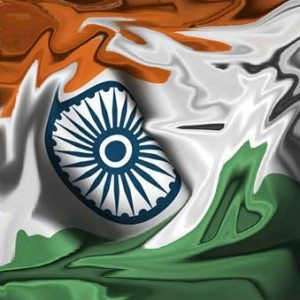
Indian Elections – The Greatest Show on Earth
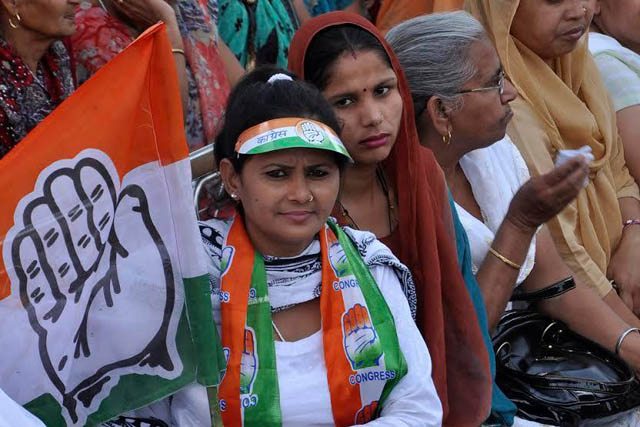
Of all the amazing, larger-than-life things about India, perhaps the most stunning is the grand spectacle of the general elections in the world’s largest democracy. It certainly is the greatest show on earth, held every five years, with millions and millions of people across this vast land standing patiently in line to invoke the power of their vote. Some may be illiterate and can only sign their name with their thumbprint – yet it is the one day they all have a voice. Without firepower or bloodshed, entire governments are changed, villains kicked out and new leaders installed.
In the last general elections in 2009, the voting population of India was 714 million and over 1 million electronic voting machines were used. Five years have passed and a lot has changed in the political landscape with new players and new parties entering the race. The voters are taken very seriously, especially in an election year, and the Election Commission of India celebrated National Voters Day in January, with the theme ‘Ethical Voting’. These functions were held in 6.56 lakh locations across the country, covering all 9 lakh polling stations. About 3.91 crore new voters were enrolled, out of which 1.27 crores are the newly eligible 18 and 19 year olds. With this, the total Indian electorate is a whopping 80 crores or 800 million.
The general elections are being held in multiple phases in 800,000 polling stations and be completed in time to constitute the 16th Lok Sabha by June 1. The world will once again see this huge mass of humanity conduct a peaceful exercise of democracy and everyone will watch with bated breath for the results.
Will it be one of the major parties – the incumbent Indian National Congress which has been in power for the past decade or the Bharatiya Janata Party (BJP) headed by the controversial Narendra Modi? Since neither has a clear majority there will have to be alliances cobbled with the regional parties which have their own agendas.
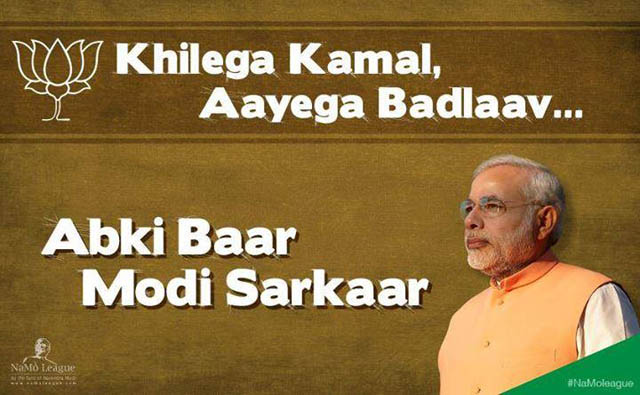
Looking into India’s Crystal Ball – A Cacophony of Voices
There are also wild cards which may influence the outcome significantly such as Arvind Kejriwal, a self-styled ‘anarchist’ who has captured the country’s imagination with his vow to weed out corruption. He recently resigned as Chief Minister of Delhi over the Lok Pal bill but his Aam Admi Party (AAP) is now fielding candidates for the national Lok Sabha against the incumbents, thus heralding a possible national role for AAP in the elections.
Although India doesn’t have any Nate Silvers, a recent Time Now -C Voter survey does look into the crystal ball. Writes Times of India: “Narendra Modi seems to be doing wonders for the BJP, which got 10 seats in 2009, as the survey shows the party sweeping with 34 seats out of total 80. While the two satraps – Mayawati and Mulayam Singh Yadav – are expected to give some fight to the BJP, the survey predicts debacle for Congress which is likely to hit the rock bottom of its worst-ever show in the state after 1977 when even Indira Gandhi and her son Sanjay lost after Emergency.”
India has a cacophony of national and regional parties and so many factors which could influence the results from the voters’ frustration with India’s stagnant economic growth, inflation and corruption which has pervaded all aspects of life in India. Then there is the emergence of a brand-new voting population – the youth who have reached voting age and constitute almost one-third of the electorate.
According to economist and Columbia professor Arvind Panagariya, prospects remain optimistic for India in the long run, even though growth has dropped to 5 percent. He feels that getting back to 7-8 percent growth is not hard to do and 15 years down the road, India could be the third largest country economically. The new government will have to take on environmental and rural development, recapitalizing the banks and look into structural growth, manufacturing which suffers because of the archaic labor laws, as well as re-organize higher education which has not changed since the 1950’s.
A strong prime ministerial candidate is mandatory to do all these tasks – and if his party comes in with 220-230 seats in the Lok Sabha, it will be easier for him to implement these changes. Anything less than that will lead to fragile coalitions of parties which may not last for long.
As India goes to the polls, the front-runner seems to be Narendra Modi, the controversial BJP leader. Sadanand Dhume of the American Enterprise Institute, says of him that he is a chief minister who’s electorally powerful having won three back to back elections and he’s managed to do this without having to run away from his public association with business. Dhume differentiates between the economic messaging of Modi and that of the BJP which he says is ‘”schizophrenic, it has a split personality’ or in the words of Swapan Dasgupta it is Marxism + cow. The Modi government is really far from that – it is minimum government, maximum governance.”
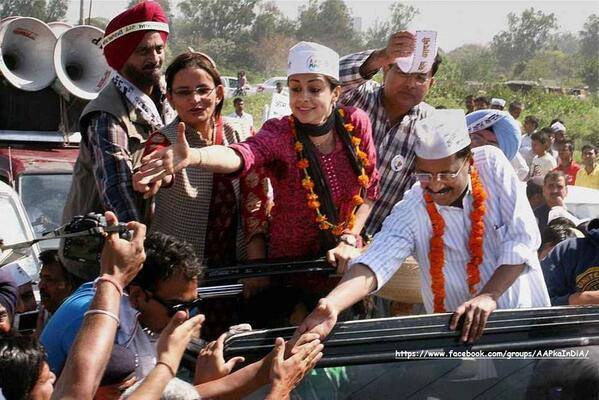
Indian Elections, American Spectators
It is indeed telling that while the elections are being played out in India, some of the most avid watchers are thousands of miles away and separated by oceans and continents – in America. Indeed the Indian Diaspora from Africa to the Middle East to Europe are all deeply involved in the outcomes but nowhere is the connection so deep as in America. Men and women who left their homeland over 30 to 40 years ago, still are moved enough to catch all the details on television, Indian newspapers and by phone calls to the family in India.
Indian NRIs, who have made America their home, still catch the news on Indian channels such as NDTV and Time Now with their morning cuppa and possibly Glaxo biscuits. Many Indians have become American citizens and ae also involved in voting in America, but somehow this election continents away does get them worked up – perhaps it has to do with their coming of age years, of a past life which is packed away with their old suits and old passport.
Thomas Abraham, the president of GOPIO (Global Organization for People of Indian Origin) came to the US in the early 1970’s, a time when many of the Indians in the US were students and newly-arrived immigrants with Indian passports. Their loyalties were very much with India but in those days of aerogrammes, telegrams and expensive phone calls, they had little access to Indian politics. There were only sporadic articles about Indian politics in the New York Times or the Washington Post and certainly no Internet, so the hunger for information had to be satisfied with Indian radio programs. Recalled Abraham: “The community had great interest in Indian politics. When Prime Minister Indira Gandhi declared Emergency Rule in India, it was the US community which stood up first and opposed it from outside. For that reason, the Government of India cancelled the passport of several activists.”
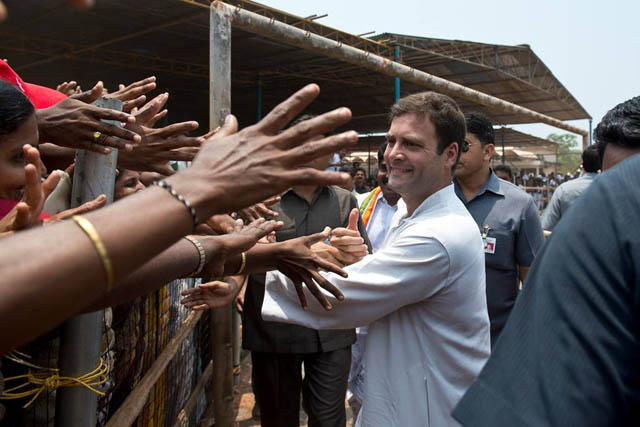
Indian Americans & The Call of the Home Country
With the changing times and thanks to the Internet, Indian-Americans are able to be totally informed about Indian politics. Said Abraham, “Although a large percentage who have become naturalized citizens and those from the second generations have no interest in Indian politics, new immigrants from India still keep active interest in Indian politics and are active supporters of political parties. Recently Aam Admi Party (AAP) got great support by American NRIs, financially as well as volunteers who took off to India before the last Delhi election.”
Indeed, the call of the home country is hard to ignore. Punyatma Sharan is one such Indian who came to New York in 1981 for his MBA, worked for Chase Manhattan Bank before starting his own business. Sharan, who moved to Atlanta in 1998, is among many Indians who never gave up their Indian passports. Although he has a green card, he never took American citizenship due to emotional reasons.
At Patna University in the 70’s, he was a popular student leader and many of his contemporaries have gone on to become MLAs and MPs. “I also have a very serious interest and have always been asked by my political friends to join the mainstream of Indian politics. I was very seriously thinking in terms of the 2014 Parliamentary elections but unfortunately, I had to go through a quintuple heart bypass surgery in December and it put everything on hold,” he said.
Sharan publishes a political website www.PolityIndia.com since 2010 and it is a well-respected one. “Even though I am a person of very strong political orientation, I neither have any affiliation with any party nor am I wedded to any political ideology,” he said. “As a matter of fact, I do support Narendra Modi to be our next PM. I am being given the credit of being the first person ever to endorse him to be our next PM. My endorsement was published in September, 2011.”
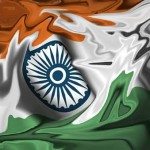
Political Candidates: “It is a job and not an entitlement”
He said that Indians living in the US are very much interested in knowing about the political events but very few of them understand the micro-face of Indian politics, relating to it at a very macro level. “There is a very serious crisis of confidence in both the major political parties,” he says. “The Congress party is not the same party of Nehru, Shastri and Patel and the BJP is not the same party of Vajpayee, Advani, Balraj Madhok, Nanaji Deshmukh. The Congress party has become a party of scams and I know a lot of people in BJP who are nothing but an extension of the Congress party. The politicians have to realize that they have been elected to do a job. It is a job and not an entitlement.”
Which brings us to the all-important question: will Indians living in the US be active participants or mere bystanders? After all, there are 2.5 million Indians living outside the country and their annual remittance to India was $69.35 Billion in 2012.
Should NRIS, with their hearts so obviously in the motherland, be allowed to vote in the elections? Actually they are by a bill passed in 2010 – but must appear and personally vote – there is no provision of voting by mail or voting in an Indian mission abroad or by online voting. Every Indian citizen staying in a foreign country, who has not acquired citizenship of a foreign country and is over 18 years of age is allowed to make an application in Form 6A to get registered in the roll for the constituency of his place of residence in India that is mentioned in his passport.
Sharan, however, is not at all in favor of NRI voting. “My thinking is based on the premise that if most of the people do not have a good understanding of the issues, it does not make much sense to get the right to vote just for the sake of it.”
Thomas Abraham believes that NRIs who hold Indian passports must be allowed to vote in the Indian elections: “There are about one million people with Indian passports. It will be unfair not to allow them to exercise their rights to vote. Most countries of the world provide that opportunity through their mission outside. India also has to develop a mechanism to implement the same or with advent of new technology, online voting must be allowed.”
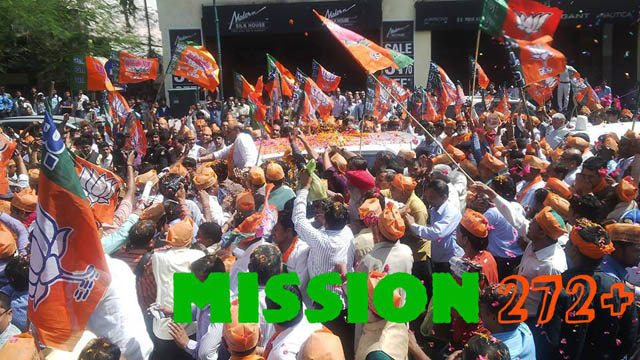
A Place for the 10 million overseas Indians?
There have been scores of articles about NRIs returning to India to help in the elections. One comment from a reader said it all: “Nothing wrong in people coming from foreign lands who mostly will be Indians settled in UK – and remember Mahatma Gandhi had also come from South Africa to participate in Indian independence struggle, and ranked father of nation.”
In fact, Abraham would like to see this acknowledgement of NRIs taken further. He says, “The time has come where the 10 million plus Overseas Indians who hold Indian passports need to be represented in the Indian Parliament, either through a couple of seats in the Lok Sabha or a couple of NRIs appointed in the Rajya Sabha.”
That too may come to pass but in the meantime political parties are not shy about asking for help from overseas Indians. Indian National Congress and BJP are very well represented in the US, while Aam Admi Party is the new entrant. In fact, all major national and regional political parties have their representation in the US, be it Bahujan Party, NCP, Trimunal Congress, Akali Dal or Anna DMK. According to Abraham, “These outfits in America are organized more as individual initiatives of people who are in touch with leadership back in India.”
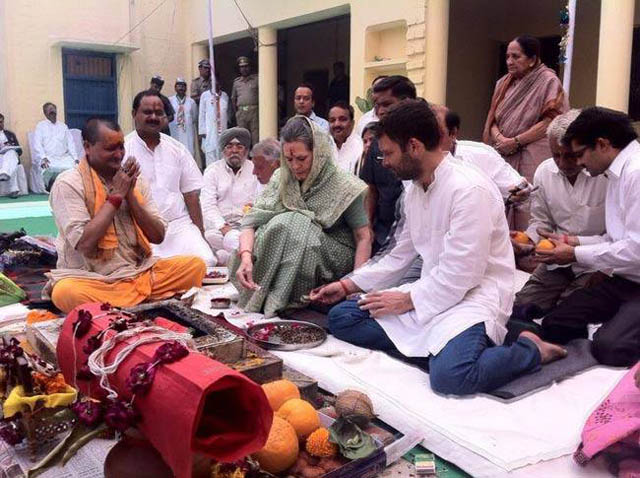
The Chaiwalla and Chai Pe Charcha
According to Sharan, the Congress party had a strong presence in the US in the 80’s, and while is too early for AAP to have an International presence, the most active party in the US is BJP. Their overseas arm, Overseas Friends of BJP (OFBJP ) has a very strong presence here.
With Modi projected as the prime ministerial candidate, the OFBJP is having a busy time. Jagdish Sehwani, one of the founders of this organization which was established in 1992, says it has 2500-3000 members but hundreds of thousands of supporters across the US. There is so much interest that Sehwani has started another group called Overseas Friends of Narendra Modi, of which he is the convener. He says, “The number of calls I’m getting is amazing – there is so much excitement about Modi being the PM candidate that people want to be a part of it.”
Many years ago Modi was a chaiwalla and he has capitalized on humble beginnings to hold Chai Pe Charchas using mobile technology to connect 1000 teastalls in each of 300 cities, reaching close to 500,000 people in India. Supporters in New York and California have replicated Modi’s famous Chai Pe Charcha meets. In Silicon Valley, young professionals met over a cup of tea to discuss how technology can help bring transparency and solve governance issues in India: “Join us in sharing a cutting chai (or a by-two coffee) that has today come to symbolize aspiration, change and hope in India. Share the chai and share your thoughts!”
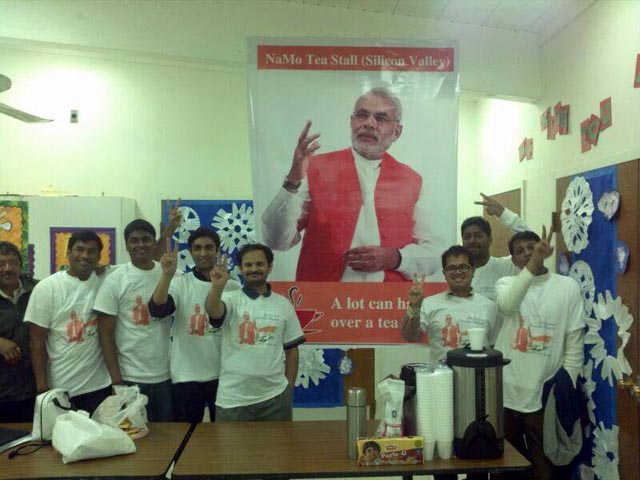
This was organized by I Care for India, a volunteer group formed on Facebook. Nihar, who volunteers with the group says, “The discussion brought out some very interesting suggestions. Participants talked of how a tool as simple as a ‘bug tracking system’ used in software industry can be used to track public grievances, how the use of simple embedded technologies can be used to create technological aids for farmers, and many other such ideas. These suggestions will be compiled and emailed across to Shri Narendra Modi so that they can be studied and used as inputs to his manifesto as well as his future policy decisions.”
After this event, I care for India has started getting queries from other volunteers based in Southern California, Houston and New York on how they could conduct such events. Says Nihar, “Through this event we have created a simple model that can be replicated elsewhere. We are sharing with them our learning and also connecting all such volunteers in a particular location through our Facebook group ‘I Care for India’ and helping them conduct the event themselves.”
You’ve heard about jury duty but now there’s Modi duty! The Economic Times wrote recently: “Holidaying NRIs are a wintertime fixture in India. This winter will be somewhat different. A large number of visiting NRIs will be on what they consider serious business – volunteering for Narendra Modi’s election campaign. ET has learnt, from talking to NRI organizations, that close to 10,000 Indians living in the US, UK, Europe and Southeast Asian countries will be on Modi duty.”
The US government has also tried to mend fences with the BJP leader and Ambassador Nancy Powell paid him a visit in his hometown of Gandhinagar and he presented her with flowers. Yet for many Indians living in the US things are not all roses as the hard facts about Modi’s involvement in the Godhra riots of 2002 remain. Here in the US you will come across two distinct groups – the Modi supporters and the progressives who do not want to forget this horrific event.
The Progressives who Cannot and Will Not Forget
Prachi Patankar is a young activist based in New York, and a member of the organizing collective of South Asia Solidarity Initiative (SASI) which organized a candlelight vigil. She says, “For many socially conscious South Asian Americans, the 2002 violence against Muslim communities in Gujarat by Hindu rightwing groups was a key moment of conscience. This mass atrocity made a deep impression on a generation of South Asian Americans here. They heard about Narendra Modi’s role as a foremost architect who allowed this pogrom to take place on his watch.”
She says that in 2005 many progressive and democratic minded Indian and South Asian organizations in the US which are part of the Coalition Aganist Genocide played a key role in getting the U.S. state department to get Modi’s US visa revoked and ban his entry to the U.S., under the provisions of the International Religious Freedom Act. Many young Indian and South Asian Americans were involved in this effort, individually or through organizations like the Youth Solidarity Summer or Alliance of South Asians Taking Action. This effort still continues with the introduction of a bipartisan resolution of November 2013 in the US House of Representatives.
In this age of social media all the candidates and parties are very much on Facebook, Twitter and Google +. So Indian-Americans are involved in both the pro and against Modi initiatives. The controversial Narendra Modi evokes great like – and dislike. A Facebook page – I support Narendra Modi – has over 2 million Likes, and you can tweet with the hashtag ChaiPeCharcha to ask ‘NaMo’ any question, states the official website www.narendramdi.in
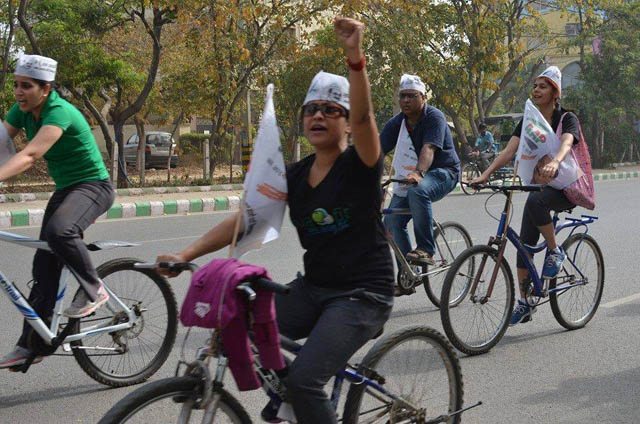
The Indian Elections on Twitter and Facebook
The Arvind Kejriwal Online Sena has over 33,000 members. and AAP members are active in several US states and some have even gone down to India to support the cause. Aam Aadmi Party Dallas group has been created to give a platform to all supporters in Dallas to interact.
You can have a Google hangout with AAP’s Prashant Bhushan – or receive a Facebook update from Arvind Kejriwal.
In one of his posts Kejriwal wrote, “When we started this fight, we knew it wasn’t going to be easy, We battled all odds, money, muscle and biased reporting, to win 28 seats in December. The time has come for us to accelerate our efforts, channelize our anger and energy to bring back AAP government with a complete majority so we can pass the Jan Lokpal and Swaraj bills.” In fact, Times of India reported that the day after Kejriwal’s resignation, donations to AAP went up 700 percent.
Knowing the avid interest of the disasporic Indians in the minute by minute play of the 2014 elections, Google has launched an elections portal in India, giving voters up to the minute access to all election-related information, Youtube videos and links to Google Hangouts with candidates.
One thing is certain – Indian-Americans as well as NRIs are much more immersed now in Indian politics due to the advent of technology; they can be part of both worlds and participate in the political process in India while sitting in America.

Check out 545 – An Effort at Columbia U
As India goes to the polls, a handful of Columbia students in America have made their own contribution – a new site called 545 – toward more communication globally about the Indian elections. Their mantra – “Neutrality is our virtue and data is our religion.” Named for the fact there are 545 seats in the Lok Sabha, this single issue website is dedicated to election news analysis that is jargon-free and accessible. Inspired by BuzzFeed and Quartz, the site with its data-driven short pieces makes political coverage digestible to all.
All six students are enrolled in the MS program at Columbia Journalism School and are from a variety of backgrounds in India: Anand Katakam, Devjyot Ghoshal, Aparna Alluri, Iva Dixit, Indrani Basu and Rishi Iyengar. Iva Dixit, who graduated from college just last year, recalls the last general election: ” Well, I was 17 the last time General Elections for the 14th Lok Sabha happened in 2009 and that too in boarding school in India. But even then one couldn’t escape the political frenzy that inevitably erupts across the nation.”
The 545 has received a lot of attention in the media in India. Starting with 15 likes on Facebook, it has already racked up 1847 Likes. For a while, the site even crashed due to demand. As Dixit points out, ” Ours is a generation that gets all of our news from social media, so our content is designed to be consumed online.” She says they’ve received overwhelming response especially from young college students, both second generation Indian-Americans and Indians studying abroad.
Indrani Basu, who also grew up in New Delhi, has this memory of the elections: “Elections for me meant lots of boring voices on loudspeakers and there was no real engagement with what politicians were saying. Even reading political news was not fun, and I think The 545 is trying to make it more interactive, invite reader involvement in this democratic process.” She feels there is immense amounts of interest in Indian politics for Indian Americans and there is also substantial funding for election campaigns from Indians in the US.
Whether they are actively involved or just passive spectators, Indians in America are certainly moved by the stirring events on the sub-continent. Bollywood is nothing compared to the great churning drama of the General Elections with its memorable characters – Narendra Modi, Sonia Gandhi, Rahul Gandhi and Arvind Kejriwal, its scores of political parties, its colorful supporting characters from party honchos to media mavens to volunteers. And of course, its mind-boggling cast of millions and millions of voters. Except in this story it is these ordinary people, these unknowns who will decide destinies and the future of a nation. As it should be, in a democracy.
(C) Lavina Melwani
(This article was first published in Khabar magazine)
Updated on April 8, 2014.

8 Comments
Via Facebook
Kuldip Chand bjp
Via Facebook
Raj Sharma #अबकी बार मोदी सरकार
Via Google +
Uttkarsh Shirodkar +1’d
Shampa Sadhya +1’d
Via Google +
Sunny Shah + 1
Via Google +
Veeru Majoka +1’d
Naveen Gupta +1’d
Ayush shah +1’d and commented
Sunil Yadav +1’d
Vinod Sharma commented
Ayush Shah via Google +
Modi is a media myth, not reality. BJP-Modi does not exist in southern or eastern or north eastern states, so it’s foolish for BJP supporters to claim 272 seats…it’s impossible.
Thank you Rakesh Prabhakar. Now we all wait to hear the ending of this exciting election story!
excellent piece!! could not wait to read till the last line